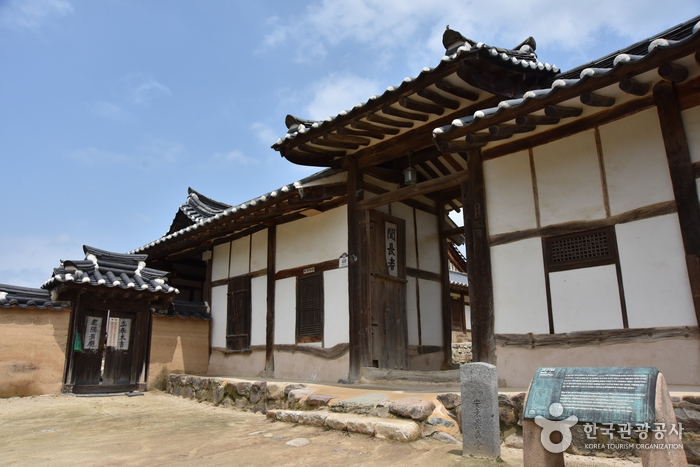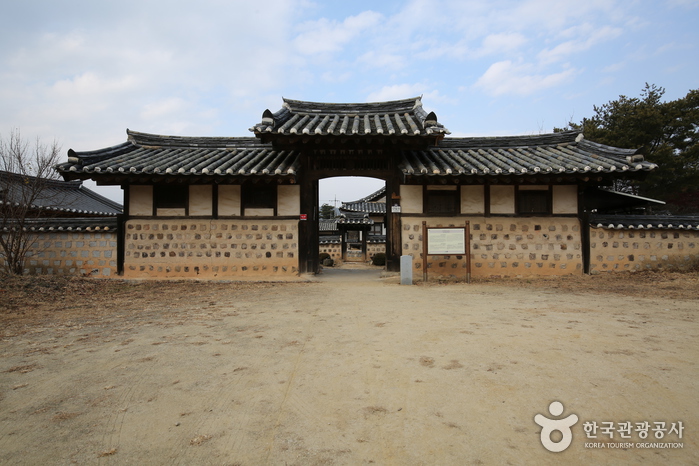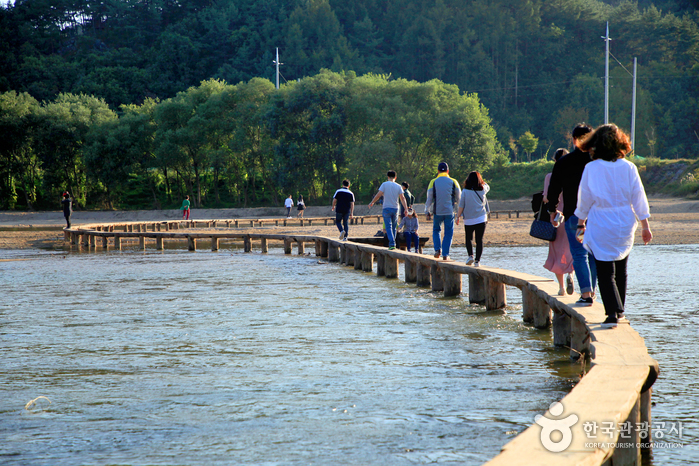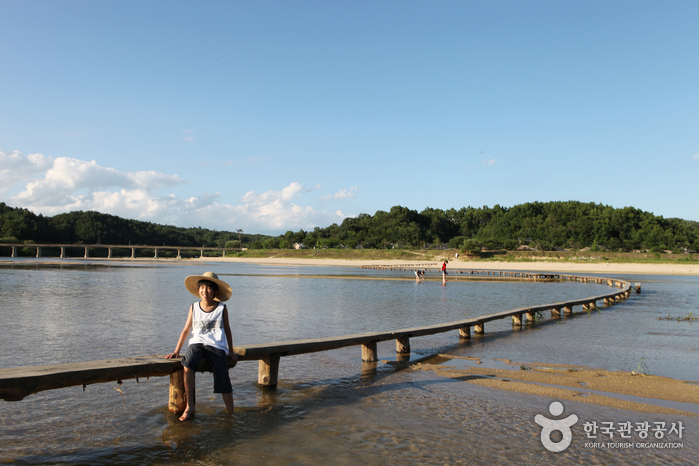Damyunjae (담연재)
17.2Km 2023-07-10
76-3 Hahoejongga-gil, Andong-si, Gyeongsangbuk-do (경상북도 안동시 하회종가길 76-3)
Damyunjae est une demeure hanok situé à Andong dans le village Hahoe. Construite dans les années 1980, il s'agit d'un très bon exemple des demeures hanok construites de manière traditionnelle. La demeure se distingue par son côté haut de gamme et ses matériaux dignes du patrimoine culturel de la Corée. Le site a notamment reçu la visite de la reine d'Angleterre en 1999 dans le cadre de son 73ème anniversaire. Le site offre désormais des formules d'hébergement adaptés pour la détente et la découverte du patrimoine.
Ga Gyeong Jae / 가경재
17.2Km 2025-08-12
69-5, Hahoenamchon-gil, Andong-si, Gyeongsangbuk-do
+82-54-855-8552
Gagyeongjae, or House with a Beautiful View, is a place with a thatched roof and an unhindered view. Guests can enjoy the view of natural environment over the window, with cool breeze freely flowing in the rooms. There are five rooms in total including Anchae Sangbang, Sarangchae Upper Room and Lower Room, Ondol Red Clay Lower Room, and Door Room. Guests in Anchae can use the central porch, whereas guests in Sarangchae can take advantage of the central floor as well. Ondol Red Clay Room is popular; it is heated by the owner himself through the traditional fireplace outside the room. The room, however, requires reservation at least 2 days in advance.
Air conditioners were recently installed in the hanok. Additional fees are separately charged in summer, but it is just great to enjoy air conditioning in a hanok. Note that reservation and inquiry over the phone is faster and more convenient than that on the website. There are many restaurants and places to experience in Hahoe Folk Village. It is a nice place to enjoy many things and just relax.
Yangjindang / 하회 양진당
17.3Km 2025-03-05
68, Hahoejongga-gil, Andong-si, Gyeongsangbuk-do
+82-10-4113-8760
“Andonog Hahoe Yangjindang,” located in the Hahoe Folk Village, is Treasure No 306 and the residence of a family with the surname Pungsan Ryu. A tablet read Ipam Antique House, named after Ipam Ryu Jung Yeong (1515 - 1573), is hung on the entrance. Yangjindang is named after the nickname of Ryu Yeong (1687 - 1761), the sixth generation of Gyeongam Ryu Un Ryong, son of Ipam. The name means “nourishing well one's own nature.” The Hanok stands over the entrance, with a well-polished floor that is grand yet friendly. One of the characteristics of the house is that it includes Sarangcha or detached building, which reflects the architecture from the Goryeo period, and Anchae or main building in the architecture style from the Joseon period.
It is expected that such co-existence was made possible because of the repairs done after Imjin War. How fortiunate that the antique house has been preserved until now! The well-tended garden shows the commitment of the descendants to maintaining the space. Rooms are rather simple compared to the grand exterior of the house. Traditional mother-of-pearl furniture, tableware in the cupboard, randomly ceramics placed draw attention. The house resembles a small folk museum. Why not enjoy some traditional folk games during your stay? There is a variety of play tools such as yut, tuho, jegi, tops, and kites. Experience programs such as gayangju brewing, rice cake and traditional dessert making, and flower tea are conducted by the first daughter-in-law of the house, depending on the season.
Chemin maritime Sunseong Susang-gil (선성수상길)
17.5Km 2024-07-08
14, Seonseong-gil, Dosan-myeon, Andong-si, Gyeongsangbuk-do
Le chemin maritime Sunseong Susang-gil désigne un chemin d'1km qui relie le complexe culturel Sunseonghyeon avec le parc du lac d'Andong. Ce chemin, qui flotte sur l'eau, donne l'impression de pouvoir marcher sur l'eau.
Yekki Maeul (예끼마을)
17.5Km 2024-07-08
14, Seonseong-gil, Dosan-myeon, Andong-si, Gyeongsangbuk-do
Le village Yekki est un village artistique à Andong. Les alllées du villages sont décorées avec des peintures murales réalisées par des artistes locaux. Le principal charme du village est le chemin de l'eau Sunseong Susang-gil, un chemin de promenade sur l'eau.
Jeongjae Head House / 정재종택
18.6Km 2025-08-12
경상북도 안동시 임동면 경동로 2661-8
+82-10-8590-0625
Boasting more than 300 years of tradition, Jeongjae Traditional House is the head house of Ryu Chi-myeong (pen-name: Jeongjae), who inherited the study of Togye Yi Hwang (1501-1570), one of the two most prominent Korean Confucian scholars of Joseon. The old house features the characteristic construction elements of a Joseon hanok, including the stylobate, wooden pillars, toenmaru (the narrow wooden porch running along the outside of the building), tiled roof, and other structures, and commands an open view of Imha Lake. The house was originally built by Ryu Gwan-hyeon, the great-great-grandfather of Ryu Chi-myeong, in 1735 (the 11th year of the reign of King Yeongjo of Joseon) in the village of Handeul in Imdong-myeon, Andong-si, Gyeongsangbuk-do, but it was relocated to the foot of Guamsan Mountain in 1987 when Imha Dam was built and the surrounding area was submerged as a result. The house consists of the daemunchae (gate building), jeongchim (a ‘ㅁ’-shaped house with a tiled roof), haengnangchae (servants’ quarters), a shrine, and a pavilion. The sarangchae (men’s quarters) is clearly visible, while the anchae (women’s quarters) is concealed within the house. The sarangchae has a sarangmaru (wooden floor), a large sarangbang room, a small sarangbang room, and there is a small maru between the two rooms. The buildings of the sarangchae and anchae are clearly divided into segregated spaces for men and women according to Confucian tradition. The anchae has a daecheongmaru (large wooden floor) in the middle; a main room, kitchen, and toilet on the right; and a numaru (upper floor) and sangbang (upper room) on the left. The small side door of the main gate links to the door by which to enter the anchae, which has a small vegetable garden. Manujeong Pavilion (Gyeongsangbuk-do Cultural Heritage Material No. 37) is a half-hipped roof building with single-layered eaves located on the left side of the house outside the main gate. It is the place where Ryu Chi-myeong used to teach his students, and consists of a large maru and a guest room. The pavilion is also surrounded by the beautiful scenery of Imha Lake, mountains, and chestnut trees. Jeongjae Traditional House provides two special experience programs: Making Songhwaju, which is the Ryu family’s home-brewed liquor (15 to 18 degrees) made with rice, glutinous rice, yeast, pine needles, and chrysanthemums, led by the owner’s wife (Intangible Cultural Asset No. 20); and Making Tarak, which is a fermented milk drink that has been made by the Ryu’s family for some 500 years. As the recipe for making Tarak is relatively simple, and uses yeast that is usually used to make raw rice wine like Makgeolli, people can easily make it at home. The house also runs a traditional music program designed to show participants how to play the gayageum (Korean zither with twelve strings) and sing Korean folk songs, and stages small concerts.
Suaedang / 안동 수애당
19.3Km 2025-08-12
1714-11, Sugogyonggye-ro Imdong-myeon, Andong-si, Gyeongsangbuk-do
+82-54-822-6661
'Suaedang Traditional House was built by Ryu Jin-geol, also known by his pen-name of Suae, in 1939. This hanok-style house consists of three buildings that measure 29-kan (a traditional measurement that corresponds to the space between two columns) in total.
The main room, or jeongchim (7-kan at front and 2-kan at sides), has a half-hipped roof, and forms a‘ㄱ’-shape with the storeroom (10-kan at front), which also has a half-hipped roof. Originally located at 612 Sugok-dong, Andong-si, the house was relocated from a slight slope to a flat piece of land due to the construction of Imha Dam in 1987. Consequently, the Jeongchim was rebuilt at a lower level than before.
The Suaedang was renovated by modernizing the old-style facilities including the kitchen, toilets, and washroom without changing their external features, while the rooms and daecheongmaru (main floored room) were decorated with red clay and natural paint. Suaedang, with its beautiful panoramic view of the lake, was designated as Gyeongsangbuk-do Cultural Property No. 56.
Village de Museom à Yeongju (영주 무섬마을)
19.8Km 2021-05-25
31-12, Museom-ro 234beon-gil, Yeongju-si, Gyeongsangbuk-do
+82-54-638-1127
Situé à Sudo-ri (Munsu-myeon, Yeongju, province du Gyeongsangbuk-do), le village de Museom est une charmante bourgade de hanok entouré d’eau. Les rivières de Naeseongcheon et de Yeongjuchon prennent leur source aux monts Sobaek et Taebaek, et convergent vers le village de Museom, l’entourant d’eau par trois côtés. Ce village semblable à une île est non seulement un haut lieu de la culture traditionnelle coréenne, mais il possède également un environnement naturel splendide, complété par une grande plage de sable et une forêt luxuriante.
Célèbre pour les maisons Haeudang et Manjukje (deux des hanoks les plus historiques de la région), le village est également connu pour ses exceptionnelles maisons traditionnelles comme la maison de Kim Gyu-jin et la maison de Kim Wi-jin. Manjukje est située au coeur du village, et elle est également appréciée par les visiteurs internationaux comme étant la plus ancienne maison traditionnelle du village de hanok. Manjukje a été construite en 1666 (lors de la 7ème année du règne du roi Heonjong) par Bak Su (le patriarche de la famille Bak de Bannam).
Près de Manjukje se trouve la maison Manun, construite au début du XIXème siècle et baptisée d’après Kim Hwi-geol, dont le nom de plume est « Manun ». La maison est devenue plus tard la résidence de l’épouse du célèbre poète Jo Ji-hun, auteur de « Byeolli », un poème exprimant la beauté du village de Museom.
Parmi les autres maisons notables, on peut citer celle de Kim Jin-wi (une maison appartenant à des aristocrates), celle de Kim Jeong-gyu (une maison dépourvue de la clôture extérieure traditionnelle) et celle de Jae-yeon, où les écrits de Bak Gyu-su (lettré appartenant à l’école de pensée Silhakpa à la fin de la dynastie Joseon) se trouvent encore aujourd’hui.
Le Pont de l’Unique Rondin constitue une autre attraction du village. Ce pont a représenté le seul lien avec le monde extérieur pendant plus de 250 ans, avant la construction du pont de Sudo en 1979. Il est minuscule en largeur (30 cm) mais On dit qu’il était reconstruit chaque année après avoir été détruit à chaque saison des pluies. Avec la construction du pont de Sudo, le Pont de l’Unique Rondin était inutile, mais il a été reconstruit quelques temps après sous sa forme originale. Pour rendre hommage à l’histoire impressionante du pont, le festival Oeinamu Dari (qui signifie Festival du Pont de l’Unique Rondin) a lieu tous les jours en octobre.
Festival du pont de l'unique rondin de l’île de Museom (무섬외나무다리축제)
19.9Km 2024-11-29
Sudo-ri, Munsu-myeon, Yeongju-si, Gyeongsangbuk-do
+82-54-639-3794
Le village de Museom est situé à l’endroit où la rivière Naeseongcheon (en amont de la rivière Nakdonggang) et la rivière Seocheon se rejoignent. Ainsi, ce village a la particularité d'être entouré d’eau. Le village est appelé « Sudori » ou « Museom », ce qui signifie « une île au milieu des terres ». Ce village traditionnel possède neuf monuments culturels, incluant Haeundang (monument folklorique n° 92) et Manjukjae (monument folklorique n° 93), deux magnifiques demeures anciennes exprimant parfaitement le formalisme simple de l’ancienne noblesse.
Le festival du pont de l'unique rondin de l’île de Museom, organisé tous les ans en octobre, est un évènement incontournable de la région de Yeongju. Le pont de Museom, formé d’une unique planche, est l’un des 100 plus beaux chemins de Corée sélectionné par le Ministère de la Terre, des Transports et des Affaires Maritimes. Le pont fait seulement 23 cm de large, et relie le village à la terre en enjambant la rivière entourant le village. Le festival a pour but de préserver et de promouvoir la culture traditionnelle de la Corée au travers de nombreuses activités folkloriques.







 Français
Français
 한국어
한국어 English
English 日本語
日本語 中文(简体)
中文(简体) Deutsch
Deutsch Español
Español Русский
Русский